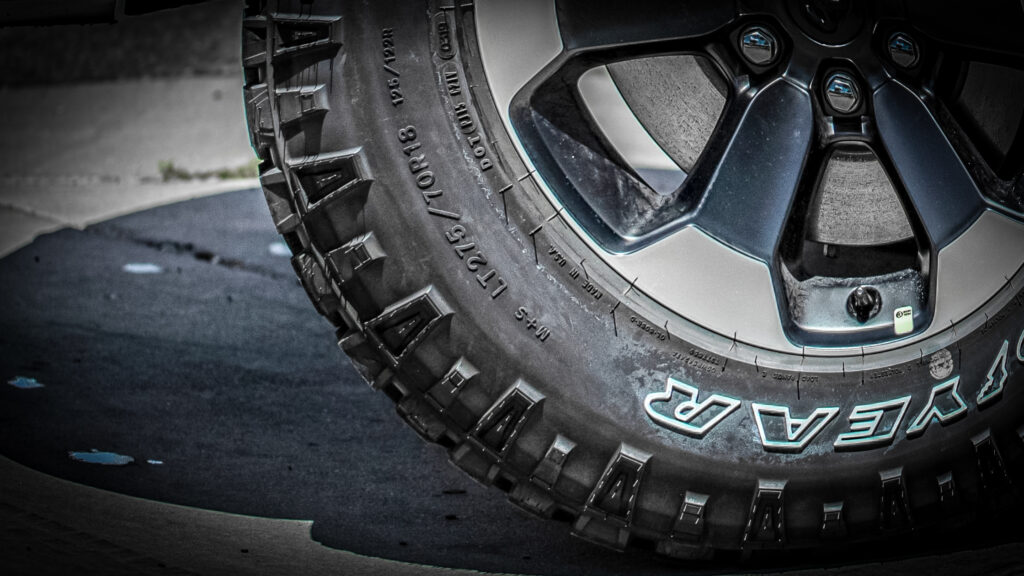The most common tires used for off-roading and overlanding generally are passenger tires and light truck tires. The advantages weighed against the disadvantages provide crucial guidance regarding what type of tire to mount on your vehicle.
While both tires are serviceable, a driver’s priorities while in the bush, the expected terrain, and the length of the expedition all should dictate which tires to put on the vehicle.
Pros and Cons of Passenger Tires
Passenger tires boast several advantages over LT tires that mainly have to do with economic gains. First, passenger tires are much lighter in weight, and therefore, provide fuel economy advantages.
Also, passenger tires generally can be accommodated onto most vehicles without the need of a lift or other work on the suspension system, axles, or differentials.
Almost all vehicles come equipped with passenger tires. Passenger tires are generally narrower, providing a smoother and more aesthetically pleasing look.
These tires offer a smooth ride on paved roads. The passenger tire is a smoother and more economical option. However, there are drawbacks to using this type of tire, especially in off-road situations.
Passenger tires have durability issues when it comes to off-roading and overlanding. I am speaking generally because some great passenger tires can be used to overland and off-road.
However, in comparison to LT tires, there are some areas of weakness in passenger tires. One disadvantage is the thinness of the sidewall.
The sidewall on a passenger tire is more susceptible to punctures as it is a less heavy-duty tire. The narrowness of the tire also is a disadvantage when in the bush.
Depending on the treads of the tire and the terrain being traveled, passenger tires can be less effective in slippery or muddy conditions because of the narrow design of the tires.
Pros and Cons of Light Truck Tires

LT tires are generally heavier and more durable tire when compared to passenger tires. This fact does offer some distinct advantages in off-road situations.
Part of the tire’s heaviness is because the tires are thicker on the tread and also in the sidewall. This provides extra durability and less risk of a puncture in extreme terrain when compared to a passenger tire.
Also, depending on the type of area you will be off-roading in, LT tires have mud tires and other options that can help gain traction in slick or wet types of conditions.
LT tires are also better suited for rocky or sandy conditions where traction is compromised. Another advantage to LT tires is in how they perform when aired down.
Due to the extra thickness and durability, LT tires perform significantly better when aired down. However, despite all of these advantages, there are still some drawbacks for LT tires.
Perhaps the most glaring drawback to LT tires is that they often provide a less comfortable ride. Passenger tires are designed for a smoother ride while on concrete or pavement.
LT tires added weight, harder treads, and wider size often make the ride on the highway much less comfortable than a passenger tire.
The weight and rough ride also hurt the fuel economy of the vehicle. Most vehicles come standard with passenger tires, and it can cost extra money or require a lift on the vehicle to equip the desired LT tires.
Eventually, what this all boils down to is how serious the driver is about off-roading and overlanding.
The Case for Passenger Tires
Passenger tires are the more economical and potentially less expensive option. However, there are risks in running them on your off-road vehicle.
If you do not want to spend a lot of time jacking up your vehicle and changing tires or patching up flats, then you may want to consider a more durable option.
Generally, passenger tires are not meant for off-roading or overlanding. However, some excellent all-terrain tires are available for those who occasionally find themselves on a rougher trail or road when getting to campsites, hiking trails, or other outdoor pursuits.
Individuals who stay on the highway for hundreds of miles and then get onto rough terrain for a much shorter amount of time can be well served by some high-quality all-terrain tires.
But, the same risks and disadvantages can apply when using this type of tire on rough terrain. Those highways miles would be much better served with a passenger tire rather than an LT tire.
The Case for LT Tires
For those interested in overlanding for weeks or months at a time, or regular rugged terrain off-roading, then LT tires are a must.
There is no question that the added durability and better tread patterns for off-roading are superior to any passenger tire. This creates a less comfortable highway experience, but you don’t want to deal with constant flats or torn-up tires when out in the middle of nowhere.
It is essential to prepare for the types of terrain that you can face and then equip a tire well suited for those conditions. LT tires can provide versatility and durability for the most hardcore of overlanders.
And LT tires can make off-roading more enjoyable as drivers can focus on the terrain and experience rather than worrying about flats or tearing up their tires.
LT tires are the ideal off-road tire. They are reliable, durable, and provide traction in challenging situations. However, they are heavy, depending on the vehicle; they may require extra work to be mounted.
They are less comfortable on paved roads and can hurt the vehicle’s fuel economy. In the end, drivers who live for off-roading and overlanding will be better served with LT tires.
Final Verdict
LT tires are the better tire for off-roading and overlanding. There is not much room for debate.
However, drivers should take an honest look at how much overlanding or off-roading they will do compared to the highway and town driving.
A good quality all-terrain passenger tire will much better serve occasional off-roaders. For those who plan to be in the bush for a large portion of the year, LT tires are the best and safest option.
- Tips and tricks For Setting Up Camp Like a Pro - September 11, 2023
- The Best Multi-Tools for Overlanding Adventures - August 25, 2023
- Off-Road Navigation Tips for Overlanders - August 13, 2023


